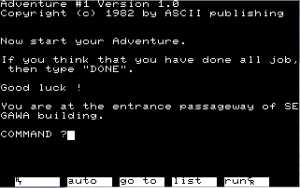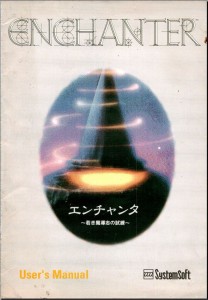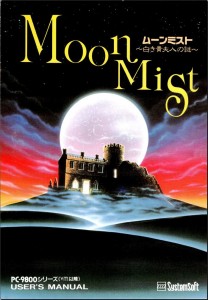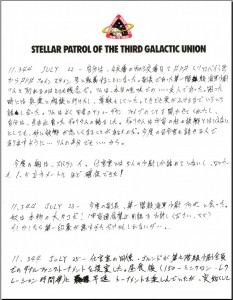One of the computers installed at Monthly ASCII‘s offices was a DEC PDP-11 minicomputer. Amongst other programs, this machine housed many of the games popular with Western institutional hackers of the early 1980s, such as Adventure and Zork. Many staffers played these games obsessively before and after working hours — and occasionally during them — in spite of the challenges their English language presented. ASCII also owned some imported Western PCs, along with early adventure games from Scott Adams, On-Line, and Infocom. With such games still unknown on homegrown Japanese machines, some staffers naturally began thinking about remedying that by writing a text adventure of their own. By this time various Western magazines had examined the technology used to develop professional text adventures. In addition to the many type-in BASIC adventures, there were articles like the one that appeared in Practical Computing in August of 1980, describing a machine-language text-adventure engine similar to the one used by Scott Adams.
With all this information at hand, two ASCII employees, Hideki Akiyama and Suguho Takahashi, proposed that the magazine develop and publish a text adventure for the 1982 Yearly Ah-SKI! parody issue. With permission granted, Akiyama developed an adventuring engine, and Takahashi wrote the first scenario for the system: Omotesando Adventure, after the street in Tokyo where ASCII‘s offices were located. It was a difficult project, particularly as both men could only work on it during down-time from their regular jobs on the magazine’s editorial staff. Still, as the first adventure made in Japan, both were determined that it should not be “shoddily made.” Omotesando was, in the words of Takahashi, a “pretty outrageous idea” for one reason in particular: despite being published in a Japanese magazine for a Japanese audience and running on Japanese computers, it was actually written in English.
Amongst the languages of the world, English, with its simple verb-object imperative construction, is rather unusually well-suited to a parser-driven adventure game. Even a related language like German makes coding a parser more complex through its many two-part verbs and its fondness for reflexive pronouns. Japanese, meanwhile, is still vastly less amenable to traditional parsing algorithms. As my translation and research partner for this article, Oren Ronen, told me, “Japanese doesn’t lend itself easily to the verb-noun pattern without sounding completely broken.” I suppose that ASCII could have had Omotesando Adventure output text in Japanese and accept input in English, but that would have created huge problems of its own, as legions of imperfect English speakers tried to figure out how to reference this or that Japanese word in the text in English. So, pure English it was — and luckily so for those of us who don’t know a lick of Japanese, as it gives us a chance to peek inside this important artifact.
Omotesando was developed on a Japanese Oki IF-800 computer running the English operating system CP/M. This machine was chosen because it wasn’t a particularly popular one with the other staffers, and thus normally spent its time gathering dust in a corner of ASCII‘s offices. When development was complete, Akiyama needed only write some bridge code for the various other Japanese Z80-based PCs, such as the very popular PC-8001 and PC-8801. With a little help from some other staffers, he soon had Omotesando running on a substantial percentage of Japanese PCs.
ASCII introduced Omotesando excitedly as a whole new experience for Japanese computer users:
Among the various things we can use a personal computer for, games are the most constant and popular. Games are in high demand, and software houses are pushing them into the market continuously. This issue we are introducing the Adventure Game. It’s an entirely new genre, the like of which was never seen on a computer. We may even call it a “New Type” of computer games.
The premise has you an employee of an unnamed rival magazine to ASCII. You’ve been ordered to sneak into ASCII‘s offices and find some way to sabotage the operation. It’s a nice change of pace from the dragons and spaceships that still dominated American text adventures, and there’s a certain postmodern sort of cleverness to all of the self-referentiality, a precursor to the generations of amateur bedroom text-adventure implementers who would get their start by implementing, well, their own bedrooms and/or apartments.
As one might expect, Omotesando is proudly old school in its design sensibilities.
Let’s state this clearly: we don’t believe you, who are experiencing an adventure for the first time, will be able to easily achieve the game’s goals. For several dozen tries you probably won’t even manage to sneak into ASCII Publishing’s offices. You will be caught in traps and die frustrating deaths. By trying again and again dozens or hundreds of times, you’ll learn things like “if I do this here I can go through” or “before I do this I must not do that” by trial and error and will be able to proceed. Solving the riddle that is the entire game can take several months and try your endurance.
In any case, since this is a game of endurance, we added the ability to save your position to a cassette and reload the game to continue from the same point. We’re very kind.
That said, to stay in the spirit of the adventure game, you must look for the way to save the game in the course of playing it (we’re not always kind). Once you find the way, you will be able to solve the game’s puzzles much more quickly.
As the illustration above shows, the English of the game is far, far from perfect. The same quirky sense of humor that marks the Yearly Ah-SKI! editorial content is as present as the sharp limitations on text length will allow. There is also the unusual (and annoying) “feature” of having to LOOK every time you enter a new room to determine what is really there. Other than that, and of course its setting, there’s oddly little about Omotesando to separate it from its inspirations. Perhaps the most surprising thing about it is that it is quite technically and even artistically competent within its modest aspirations. If you’d like to experience it for yourself, I’ve prepared a little care package for you. It includes Omotesando packaged up with a Japanese PC-8001 emulator as a Windows executable, along with translations and originals of the magazine articles that accompanied it. Sorry to be so platform-specific this time. Given the trials and tribulations of Japanese, this was about the best I could do. I do believe it should also run fine under WINE.
Omotesando Adventure, then, marks the beginning of the text adventure’s brief, precarious existence in Japan. The following year’s Yearly Ah-SKI! brought another, more complex game, once again implemented in English. By that time a Japanese company called Starcraft had begun a project to translate some of the more popular American illustrated text adventures for the domestic market, including most of On-Line’s Hi-Res Adventure line (with the expected exception of the white elephant Time Zone). Still, the difficulty of parsing Japanese made these games an awkward fit for the country; some actually resorted to making the player type a Japanese verb, hit enter, and then input a noun as the least painful and grammatically ugly approach.
As an alternative to such kludges, amateurs and professionals alike soon began experimenting with menu-driven interfaces in place of parsers. Thus was born the tradition of the Japanese visual novel, which became extraordinarily popular in spite of or because of the fact that many were partly or entirely exercises in pornography. Whatever objections some might have to their subject matter, or frustrations with their limited scope for player choice, these games did at least depart definitively from text adventures’ obsessions with puzzles and low-level object interactions to focus on telling more complex stories at a less granular level than most of their peers in the West. In fact, visual novels and the related genre of dating simulations remain important to Japanese computing culture even today, decades after text adventures faded from store shelves in the West.
A much more successful Western genre in Japan in comparison to the text adventure was the CRPG. Wizardry and its sequels in particular were massively popular when translated into Japanese. Just as the Beatles and other British groups of the 1960s mirrored back to America the music that America had originally created, Japanese CRPGs eventually made their way back to the West, where their unique, heavily story-oriented sensibility made them more popular with many players than the more hardcore, stats-oriented Western games.
Indeed, I’m afraid this blog will necessarily have to view Japan mostly through the lens of the West, through the games that made it back to these shores in English translations. I don’t know any Japanese, you see, and, while Oren did amazing work to help me with this article, I can’t expect him to keep doing my research and translating huge chunks of material for me. So, take this article as primer only on what was going on inside a country that would soon become hugely important to Western gaming culture. But before I move on, I’ll leave you with one last historical curiosity from inside Japan that Oren dug up for us.
During the early 1990s, after parser-driven games were considered commercially dead not only in Japan but also in the West, four of Infocom’s classic titles were ported to Japanese computers, and translated into Japanese in the process. Let me just let Oren finish this story:
There were 4 translations: Zork 1 is the only one that’s mentioned anywhere on the western web, but that’s only because it got a strange console release on the PlayStation and Sega Saturn. Most references get the facts wrong by saying those were the only releases it got. In fact, there was also a PC release with a proper text-entry based parser. In addition, Enchanter, Planetfall and (of all things) Moonmist got translations. All were wrapped in a fancy, Zork Zero-like interface with a changing graphical background depending on your location, a clickable compass-rose, and menus for saving and loading the game. They were released in the early ’90s by a software company called SystemSoft that mostly did game localizations for the Japanese market. They all mention Activision in the documentation, so the deal was made after Infocom’s buyout. The translations themselves are pretty good, as far as my non-native literary appreciation skills can tell.
The most remarkable thing about them is that they are the best implementation I can find anywhere of an IF parser in Japanese. Because of the complexity of parsing Japanese text, adventure games moved to menu-based systems much faster than in the West, and the few parser-based games that were released either required input in English or did a no-frills two word Japanese parser that was completely ungrammatical. The Infocom games parse complete, grammatical Japanese sentences (which is, again, a much more difficult task than in English) and even do all the fancy Infocom tricks like “take all except the stone” and remembering context for pronouns. I’m quite amazed they went through all the effort several years after parser-based games were completely forgotten about in the country.
The translations even reproduced the feelies from the original American releases. Alas, it appears they were, unsurprisingly, not successful, and they mark the last gasp of the text adventure’s short and fitful life in Japan.
(My thanks again to Oren Ronen for all his help researching and translating for this article and the preceding one, which included translating a short interview with the designers of Omotesando Adventure.)















Jonno
July 29, 2012 at 1:02 pm
“four of Infocom’s classic titles were ported to Japanese computers, and translated into English in the process” – should that say they were translated into *Japanes* instead of into *English*?
Jimmy Maher
July 29, 2012 at 1:03 pm
Yes, thanks — fixed it!
Sniffnoy
July 29, 2012 at 1:05 pm
The restricted saving — having to find a way in-game to save — was that introduced by this game (at least in IF)? You haven’t mentioned it in any previous entries. (Note here I’m talking just about restricting saving by having it have some in-game requirement (like in, say, Resident Evil) not restricting saving by disallowing save scumming (like in Nethack).)
Jimmy Maher
July 29, 2012 at 1:07 pm
I can’t think of any previous examples, so very possibly. As a matter of fact, I can’t think of any subsequent examples either in the field of text adventures.
matt w
July 29, 2012 at 1:07 pm
Reliques of Tolti-Aph does, I think. You can only (SPOILERS) save when in your
sanctuary, which you have to create by learning and casting a spell — I forget how
it communicates this fact.
Oren Ronen
July 29, 2012 at 1:09 pm
One other Infocom oddity I’m not sure I mentioned to you was the Infocom game books published in Japan around 1987. As far as I can tell there were nine – three Zork books, three Enchanter books (named after the individual games), and three mystery books – Witness, Suspect and Deadline. They were traditional CYOA books with flags and an inventory, all based on games that were never released in Japan at that point in time (the translated Enchanter and Zork came later), and all written by Japanese authors. That’s pretty much all I know, though – I’m not sure how much they’re directly based on the original games, or if they just use them as inspiration. One of these days, I’ll track down copies of some of them…
You can see the covers and descriptions (in Japanese) for Zork 1 and Witness in this promotional excerpt from a Japanese booklet about the subject, here: http://tradersguild.web.fc2.com/allabout/pdf/allabout02_sample.pdf
Jimmy Maher
July 29, 2012 at 1:14 pm
Thanks for that! It’s odd that the Japanese publisher thought they were worth licensing, considering that they had no name recognition inside Japan.
And so, so sorry to have mistyped your last name in the first edition of this post. Really, really inexcusable after all the work you did with me on this one. Sometimes it seems I need a copy editor for this blog…
Nori
September 6, 2012 at 3:12 pm
That’s correct. There are nine titles of Japanese Infocom game books, all published in 1987.
At that time, there was a huge interest for computer games among Japanese youth but PC games were expensive for them and there was a demand for substitutes. And Infocom titles were, although not ported in Japanese machines, regularly mentioned in computer game magazines so there were some recognitions of them.
Anthony
July 29, 2012 at 1:15 pm
Absolutely fascinating.
(Typo, I presume?: “four of Infocom’s classic titles were ported to Japanese computers, and translated into English”)
Mark
July 29, 2012 at 10:46 pm
This might be a slightly off topic but I wanted to ask you about modern text adventure games set in the far east. While look over your recommendation list I noticed there was not entry for Lesson of the Tortoise,Sound of One hand Clapping, or Katana. These as you know are modern post 1993 but pre 2006 text games. I have not played any of the these three games. Have you and would you recommend them?
Jimmy Maher
July 30, 2012 at 6:36 am
Sorry, those games aren’t ringing enough bells in my head that I feel I have anything intelligent to say about them without replaying. Which doesn’t mean they aren’t worthy efforts, of course.
Simon
July 29, 2012 at 11:33 pm
In addition to the many type-in BASIC adventures, there were articles like the one that appeared in Practical Computing in August of 1980, describing a machine-language text-adventure engine similar to the one used by Scott Adams.
Link to said article (PDF): http://www.vintagecomputers.btinternet.co.uk/mags/praccomp/1980/80aug_Adventure_II.pdf
Joshua Bowman
August 11, 2014 at 8:17 am
Amazingly, there’s still a copy of it on archive.org! http://web.archive.org/web/*/http://www.vintagecomputers.btinternet.co.uk/mags/praccomp/1980/80aug_Adventure_II.pdf
Sslaxx
August 9, 2012 at 11:46 am
I’ve never seen anything of the boxart or manuals for these translations and I was completely unaware of Moonmist or Planetfall. Nice find! Would love to see more of these obscure gems.
YOIS
October 19, 2012 at 4:51 pm
Thanks for posting this. I’d been aware of the Japanese Zork and Planetfall for quite some time, and recently discovered the existence of Enchanter on my own, but Moonmist was complete news to me.
It may interest you to know that both the Japanese console (Playstation/Saturn) and PC versions of Zork had their own guide books published. I haven’t seen them for any of the other titles.
There is also a Japanese release of Quarterstaff: The Tomb of Setmoth, which you may or may not count as an Infocom title since it was a re-release of an obscure RPG by another company. Activision bought the rights to it from Simulated Environment Systems and released it under the Infocom label, although Implementor Amy Briggs did do some of the writing in the remake. The Japanese version is translated from Infocom’s, as it includes the infamous wooden coin and parchment needed to decipher magic word commands.
Martin
June 1, 2016 at 1:00 am
Your comments about both German and Japanese being difficult to create realistic simple parsers. So is there any language that is really suited to parser creation? Would the text adventure simply not have come to pass if English wasn’t the dominant computing language.
Jimmy Maher
June 1, 2016 at 7:20 am
I don’t feel like I know enough to answer that. The Scandinavian languages have grammars that are fairly close to English. German-style two-part verbs are by no means unknown, but they’re much less common and can usually be avoided with other word choices. You do have to deal with noun genders and the alternative adjective endings that result, but there are at least only two genders. Beyond that, I just don’t have the linguistic competency to say.
Adam Huemer
February 19, 2025 at 7:39 pm
Ehrm… in German language there are three genders.
Sam Ursu
July 27, 2021 at 12:16 pm
Yes, there are some languages that would suit parsers, but before we get into that, let’s see why parsers fail so often in other languages.
To begin with, most languages have grammatical genders, and these are often reflected in even very short sentences. For instance, “he said” and “she said” in Russian (as well as most other Slavic languages) uses a different VERB form for each gender, not just a different pronoun.
Secondly, many languages (including Romanian and Slavic languages) still use noun cases, meaning that even nouns get “conjugated” (modified) depending on how they are used in a sentence. For instance, “he ate the bear” and “the bear ate him” would write the word “bear” in a different way, depending on whether it was the object of the sentence or not.
Third, even in relatively uninflected languages like Spanish or Italian, adjectives must agree both in gender and number, meaning that “the car is green” and “the cars are green” use two different words for “green”, one indicating a singular green thing (“verde”), and the other a plural (“verdes”).
Fourth, almost all languages (besides English) have a number of reflexive verbs. In short, a verb that you do to yourself (such as washing your hands) is formatted differently than a verb referring to an action taking place between a person and something else (like washing a car). This means that any parser would need to take into account BOTH the reflexive and non-reflexive forms of the verbs, in many cases.
Add in each language having a propensity for a wide number of exceptions to their various rules, and it makes straightjacketing a language into the classic “noun verb” two-word formation very difficult to do without either a) being grammatically wrong or b) sounding and feeling very “off” to the point that it breaks immersion (as the Japanese implementors figured out in this article).
English players might be okay with a rather ambiguous “get lamp” (who is getting the lamp? And is it “a” lamp or “the” lamp? Doesn’t matter!) but few other languages allow for such vagueness, particularly when it comes to the definite article. Saying “get lamp” in Spanish without a “the” in the middle sounds very, very weird.
All of the above being true, however, some languages would be nearly ideal for the old-school parser, primarily the Finno-Ugric branch (of “European” languages). Hungarian, for instance, has no genders at all (not even a “he” or “she”) but it does, unfortunately, require a lot of customization to get the right suffix on the noun. Finnish likewise could probably be shoehorned into a two-word parser, but none of the F-U languages have the ambiguous flexibility of English.
Long story short, Indo-European languages (including Persian and Hindi) are pretty poor choices for a two-word parser even if they aren’t further hobbled by non-Latin alphabets. I rather imagine Chinese would be more suitable if not for the writing system problem. Frankly, it looks like Thai and Bahasa (the language of Malaysia and Indonesia) would more suitable, although Thai’s heavy use of classifiers would make it difficult.
In summary, Bahasa with a three-word parser (and a strict adherence to only the imperative form of verbs) and possibly some languages such as Swahili would do very well. Their grammar constructs are simple and flexible enough, and they use a standard (Latin) alphabet for writing. So yeah, if the Zork guys had been born in Zanzibar or Jakarta in another universe, we might’ve still gotten text adventures.
Worth noting here that DESPITE all of the difficulties briefly enumerated above, the French did yeoman’s work in creating an astounding variety of text adventures in the 80s.
Lisa H.
July 27, 2021 at 7:39 pm
I wonder how one might parse an agglutinative language where it seems the player could easily “invent new words” on the fly (not exactly, but could provide unpredictable input), but mostly I’m just juvenilely giggling at the abbreviation here of the “F-U” languages. Some of their shenanigans (or so they may seem to an English speaker) sure are “F-U”, all right :)
Christian G.
July 26, 2017 at 1:36 pm
A note about Time Zone: “By that time a Japanese company called Starcraft had begun a project to translate some of the more popular American illustrated text adventures for the domestic market, including most of On-Line’s Hi-Res Adventure line (with the expected exception of the white elephant Time Zone).”
It’s true that Time Zone wasn’t initially converted, but it would eventually appear on the PC-88, PC-98 and FM-7 computers. The Japanese databases give 1985 dates for those releases. Disk images can be found on the web.
I had your blog already bookmarked, but google led me here because I was looking for info about the American Infocom PC-80x releases. Not exactly what I was looking for, but I find it fascinating that the Japanese Infocom releases are in many ways better documented than the American NEC ones! NEC released variants of all their major computers in the west, but preservation and documentation of the available software seems to be really lacking (not that there was much, but still..)
Oren Ronen
July 31, 2018 at 12:26 am
Coming back to this years later, but I just found an additional bit of information in a 2015 autobiographical book by Susumu Furukawa, the founder of Microsoft Japan which span off from ASCII (who handled part of Microsoft’s Japanese business before a full fledged subsidiary was established), who was also involved with a lot of other ASCII stuff in the early ’80s.
There’s a short page on Omotesando Adventure, mostly covering what I’ve already known, but the one new bit of information is that it was apparently created using Adven-80, an adventure creation system by Peter D. Scargill published in issue 61 of Dr. Dobb’s Journal. I can’t find copies of the original article online, but the system itself is on if-archive.
One other thing mentioned is that Hideki Akiyama shut himself in Akasaka Tokyuu Hotel with the if-800 computer to program this game. The hotel (renamed the Akasaka Excel Hotel Tokyu these days) is a 2 minute walk from the office I’m currently sitting in and I often pass by it on my way to lunch.
Jason Dyer
February 10, 2020 at 12:55 pm
The Adven-80 article is here:
https://archive.org/details/dr_dobbs_journal_vol_06/page/n485/mode/2up
Will Moczarski
June 23, 2020 at 8:05 pm
The premise has you an employee of an unnamed rival magazine to ASCII.
-> as an employee?
and the proceeding one
-> the preceding one?
Jimmy Maher
June 25, 2020 at 10:51 am
Thanks! (The first was actually as intended…)
Ben
July 4, 2020 at 8:00 pm
amendable -> amenable
Jimmy Maher
July 6, 2020 at 8:31 am
Thanks!
Robert J Pitt
February 2, 2021 at 6:07 pm
Is there anywhere I can purchase these Japanese versions?